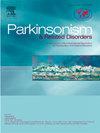The impact of anti-inflammatory therapy on Parkinson's disease incidence: A retrospective cohort study
IF 3.1
3区 医学
Q2 CLINICAL NEUROLOGY
引用次数: 0
Abstract
Background
Previous research suggests shared pathophysiology between Parkinson's Disease (PD) and autoimmune disorders, with inflammation reduction as a potential PD intervention. The impact of anti-tumor necrosis factor (anti-TNF) and anti-interleukin (IL)-17 drugs on PD development has yielded conflicting results.
Objectives
The study investigated the association between PD incidence and immunosuppressive anti-inflammatory drugs in patients with autoimmune diseases (rheumatoid arthritis, ulcerative colitis, Crohn's disease, ankylosing spondylitis, psoriasis/psoriatic arthritis).
Methods
A retrospective study was conducted using data from 2014 to 2022 from the US Komodo Health claims database. Two cohorts of patients diagnosed with autoimmune diseases were designed: 1) exposed to biologic disease-modifying antirheumatic drugs (bDMARDS e.g., anti-TNF/anti-IL-17 drugs) and 2) absent such exposure. Person-time incidence rates of PD per 100 person-years (PY) and incidence rate ratios (IRRs) were calculated and covariate adjusted via Poisson regressions.
Results
Among 2,105,677 identified patients with autoimmune disease, 114,082 were treated with anti-TNF/anti-IL-17 and 1,991,595 were not. Unadjusted analyses indicated lower PD incidence in those treated with bDMARDscompared to the not treated (0.661 vs 0.949 per 100-PY; IRR 0.696 [95 % CI: 0.669–0.724]). Multivariate Poisson models comparing cohorts exposed to bDMARDs vs those lacking exposure resulted in significantly lower risk of PD (adjusted IRR 0.77 [95 % CI 0.74–0.80], p-value <0.0001). For patients exposed to anti-TNF or anti-IL-17 therapies, the IRRs were 0.77 (95 % CI 0.74–0.81) and 0.64 (95 % CI 0.52–0.80), respectively (p-values<0.001).
Conclusions
The results suggest that reduced systemic inflammation via anti-TNF or anti-IL-17 treatment may decrease PD risk in patients with autoimmune diseases.
抗炎治疗对帕金森病发病率的影响:回顾性队列研究
背景:先前的研究表明帕金森病(PD)与自身免疫性疾病之间存在共同的病理生理学,减少炎症可能是帕金森病的一种干预措施。抗肿瘤坏死因子(anti-TNF)和抗白细胞介素(IL)-17药物对帕金森病发展的影响产生了相互矛盾的结果:该研究调查了自身免疫性疾病(类风湿性关节炎、溃疡性结肠炎、克罗恩病、强直性脊柱炎、银屑病/银屑病关节炎)患者PD发病率与免疫抑制抗炎药物之间的关联:利用美国 Komodo Health 索赔数据库中 2014 年至 2022 年的数据进行了一项回顾性研究。研究设计了两组确诊为自身免疫性疾病的患者:1)接触过生物疾病修饰抗风湿药(bDMARDS,如抗 TNF/ 抗 IL-17 药物)的患者;2)未接触过此类药物的患者。通过泊松回归计算出每百人年(PY)PD的个人时间发病率和发病率比(IRR),并进行协变量调整:在 2,105,677 名已确认的自身免疫性疾病患者中,114,082 人接受了抗肿瘤坏死因子/抗 IL-17 治疗,1,991,595 人未接受治疗。未经调整的分析表明,与未接受治疗者相比,接受 bDMARD 治疗者的 PD 发病率较低(每 100-PY 0.661 vs 0.949;IRR 0.696 [95 % CI:0.669-0.724])。多变量泊松模型比较了暴露于 bDMARDs 与未暴露于 bDMARDs 的队列,结果显示 PD 风险显著降低(调整后 IRR 为 0.77 [95 % CI 0.74-0.80],P 值 结论):研究结果表明,通过抗肿瘤坏死因子(anti-TNF)或抗IL-17治疗减少全身炎症可降低自身免疫性疾病患者的晚期脱发风险。
本文章由计算机程序翻译,如有差异,请以英文原文为准。
求助全文
约1分钟内获得全文
求助全文
来源期刊

Parkinsonism & related disorders
医学-临床神经学
CiteScore
6.20
自引率
4.90%
发文量
292
审稿时长
39 days
期刊介绍:
Parkinsonism & Related Disorders publishes the results of basic and clinical research contributing to the understanding, diagnosis and treatment of all neurodegenerative syndromes in which Parkinsonism, Essential Tremor or related movement disorders may be a feature. Regular features will include: Review Articles, Point of View articles, Full-length Articles, Short Communications, Case Reports and Letter to the Editor.
 求助内容:
求助内容: 应助结果提醒方式:
应助结果提醒方式:


